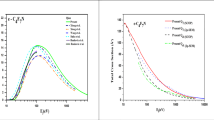Abstract
Peaks of C60(CF3) 2− n doubly charged negative ions (n = 6–12) have been observed in the mass spectra of the resonance electron capture by trifluoromethylfullerene C60(CF3)12 molecules. It has been established that these ions are formed owing to the attachment of two free isoenergetic electrons. The autodetachment of an extra electron has been detected for the doubly charged molecular ions (n = 12). It has been established from the observation of the delayed fragmentation of the most abundant ions with n = 8 and 10 that the doubly charged negative ions, like their singly charged analogs, are metastable with respect to the separation of the CF3 fragment(s). The yield of doubly charged negative ions has been obtained as a function of the electron energy. By comparing them with the analogous dependences for the singly charged ions, the specific features have been revealed which were associated with the presence of the repulsive Coulomb barrier and the regular effect of the doubled energy of two additional electrons on the energy dependence of the dissociative decay of the doubly charged negative ions. The absolute cross section for the formation of the C60(CF3) 2−10 ions has been measured. At the energy of their yield maximum near the 5 eV, it is ∼1 × 10−19 cm2.
Similar content being viewed by others
References
K. Vekey, Mass Spectrometry Rev. 14, 195 (1995).
M. K. Scheller, R. N. Compton, and L. S. Cederbaum, Science 270, 1160 (1995).
H. G. Weikert, L. S. Cederbaum, F. Tarantelli, and A. I. Boldyrev, Zeitschr. Phys. D 18, 299 (1991).
A. Dreuw and L. S. Cederbaum, Phys. Rev. A 63, 049904 (2001).
A. I. Boldyrev, M. Gutowski, and J. Simons, J. Acc. Chem. Res. 29, 497 (1996).
X.-B. Wang and L.-S. Wang, Nature 400, 245 (1999).
J. H. Bowie and D. J. Stapleton, J. Am. Chem. Soc. 98, 6480 (1976).
H. Gnaser, Nucl. Instrum. Methods Phys. Res. B 149, 38 (1999).
T. Arthur, J. Am. Chem. Soc. 116, 10761 (1994).
X.-B. Wang and L.-S. Wang, Ann. Rev. Phys. Chem. 60, 105 (2009).
A. V. Streletskiy, P. Hvelplund, S. B. Nielsen, et al., J. Chem. Phys. 124, 144306 (2006).
C. Jin, R. L. Hettich, R. N. Compton, et al., Phys. Rev. Lett. 73, 2821 (1994).
R. N. Compton, A. A. Tuinman, C. E. Klots, et al., Phys. Rev. Lett. 78, 4367 (1997).
R. L. Hettich, R. N. Compton, and R. H. Ritchie, Phys. Rev. Lett. 67, 1242 (1991).
T. Drewello, H. Frauendorf, R. Herzschuh, et al., Chem. Phys. Lett. 405, 93 (2005).
O. V. Boltalina, A. V. Streletskii, I. N. Ioffe, et al., J. Chem. Phys. 122 (2005).
J. Hartig, M. N. Blom, O. Hampe, and M. M. Kappes, Int. J. Mass Spectrom. 229, 93 (2003).
R. V. Khatymov, V. Yu. Markov, R. F. Tuktarov, et al., Int. J. Mass Spectrom. 272, 119 (2008).
V. A. Mazunov, P. V. Shchukin, R. V. Khatymov, and M. V. Muftakhov, Mass-spektrom. 3, 11 (2006).
S. I. Troyanov, A. Dimitrov, and E. Kemnitz, Angew. Chem. Int. Ed. 45, 1971 (2006).
R. F. Tuktarov, R. V. Khatymov, V. Yu. Markov, et al., JETP Lett. 96, 664 (2012).
V. Yu. Markov, V. E. Aleshina, A. Ya. Borschevskiy, et al., Int. J. Mass Spectrom. 251, 16 (2006).
R. V. Khatymov, R. F. Tuktarov, A. V. Pogulyai, and M. V. Muftakhov, Russ. J. Phys. Chem. B 3, 770 (2009).
R. G. Cooks, J. H. Beynon, R. M. Caprioli, and G. R. Lester, Metastable Ions (Elsevier Scientific, Amsterdam, 1973).
R. V. Khatymov, P. V. Shchukin, R. F. Tuktarov, et al., Int. J. Mass Spectrom. 303, 55 (2011).
D. N. Laikov, Chem. Phys. Lett. 281, 151 (1997).
V. S. Prabhudesai, D. Nandi, and E. Krishnakumar, Eur. Phys. J. D 35, 261 (2005).
R. F. Tuktarov, R. V. Khatymov, P. V. Shchukin, et al., JETP Lett. 90, 515 (2009).
R. V. Khatymov, R. F. Tuktarov, and M. V. Muftakhov, JETP Lett. 93, 437 (2011).
Author information
Authors and Affiliations
Corresponding author
Additional information
Original Russian Text © R.V. Khatymov, R.F. Tuktarov, V.Yu. Markov, N.A. Romanova, M.V. Muftakhov, 2012, published in Pis’ma v Zhurnal Eksperimental’noi i Teoreticheskoi Fiziki, 2012, Vol. 96, No. 10, pp. 732–737.
Rights and permissions
About this article
Cite this article
Khatymov, R.V., Tuktarov, R.F., Markov, V.Y. et al. On the energy dependence of the yield of doubly charged negative ions during the capture of free electrons by C60(CF3)12 trifluoromethylfullerene molecules. Jetp Lett. 96, 659–663 (2013). https://doi.org/10.1134/S0021364012220055
Received:
Accepted:
Published:
Issue Date:
DOI: https://doi.org/10.1134/S0021364012220055




